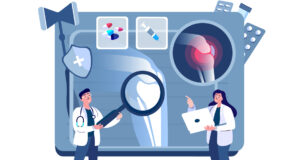
The Post-Pandemic Life of a Workers’ Comp Case Manager
BY THERESE M. QUINN, RN, BSN, CRRN, CCM, JD
A professional nurse case manager has an interesting role in the arena of workers’ compensation. Aside from developing a thick skin, a nurse case manager must demonstrate excellent communication skills in order to facilitate communication between all parties, including the injured worker, the employer, the providers and the insurance claims adjusters. It is important to explain the role of the case manager when interacting with injured workers, as well as with medical office staff. This often involves explaining the difference between a professional case manager and a case worker.
The goal for case management is to ensure that the injured worker is receiving medically necessary care and that they are receiving quality and cost-effective treatment. Knowing this comes from clinical experience and expertise, which is forever growing.
Prior to the COVID-19 pandemic, the most effective way to build trust and formulate a relationship with injured workers was to meet face to face and show them that the nurse case manager is an advocate for them. The pandemic taught us that we had to pivot quickly and adapt to continue meeting the needs of our injured worker clients. Telemedicine became an essential factor in allowing this to happen, and it has become more mainstream even as life has been getting back to normal post-pandemic. Using telehealth as a tool has allowed case managers to be more efficient. It eliminates wasted time sitting in waiting rooms and driving to and from appointments. The case manager is still able to coordinate medical care by scheduling appointments, securing authorization for treatment, facilitating procedures and monitoring compliance with treatment.
Meeting with injured workers in person was always better. Being present at appointments allows the nurse case manager to hear first-hand the doctor’s opinions and recommendations. When forced to shift gears in 2020, the technology available to nurse case managers proved to be essential. We can still “attend” appointments virtually. During the pandemic, we would have three of us on the screen – the injured worker, the provider and the case manager. Physicians and therapists were able to evaluate patients and provide education and treatment via Zoom appointments. As injured workers have gone back to in-person appointments, it is sometimes important for the case manager to also be present in person; however, it often proves to have the same impact if the case manager attends the appointment virtually.
On the negative side, the nature of healthcare has changed since the pandemic. Medical offices have experienced staffing issues, and many of the offices have staff who work from home. Wait times on the phone have increased, and often multiple calls are required to get a response. What I have noticed is that I get better and more efficient results if I set a positive tone with phone calls and messages. Positive energy can be transmitted through phone contact if they sense a cheerful, unstressed tone. It really does work!
The process does not always go smoothly. Insurance claims adjusters tend to be overworked and overextended. This requires the case manager to be persistent with communicating and facilitating authorizations for treatment. Case managers can make life easier for claims adjusters by staying on top of everything and keeping them informed. When utilization review is required, there is another hurdle to surmount. When the case manager can present details of a case to the claims adjuster outlining the urgency and timeliness of approval, sometimes the claims adjuster will override UR and approve treatment. This most often depends on the adjuster trusting the expertise of the case manager.
Most importantly, the case manager should always be prepared with an understanding of the injured worker’s job and being able to recognize the level of motivation to return to work once it is safe to do so. This should always be communicated to the physicians. It is easy for the physician to take the injured worker out of work completely, but if the case manager can educate the physician about identifying specific restrictions or limitations, they can determine what the injured working is actually capable of doing, and the employer may be able to accommodate modified work activities while the injured worker recovers from the injury. Oftentimes, the injured worker tells the physician that there is no light duty, so they just keep them out of work.
It is all about being honest and straightforward. The case manager has to present a level of confidence that informs the injured workers that they will be offered the most appropriate treatment available, and that they have a responsibility to do their part as well. This means that they must attend appointments and communicate honestly with the case manager. The outcome will be a win-win situation. If, however, the injured worker has a different agenda, it is important for the case manager to recognize this and communicate it to the employer and the claims adjuster, as well as to the physician.
This writer has been a workers’ comp case manager for over 26 years. The changes have been remarkable. One of the most important innovations has been navigation systems. Additionally, most everyone has a cell phone, so communication has advanced with easy accessibility, text messaging, and FaceTime. Zoom and other virtual meeting platforms have made case management more efficient.
 Therese M. Quinn, RN, BSN, CRRN, CCM, JD, has been working in the medical field for over 37 years. As an RN, she worked on a neurosurgical/trauma unit and was active in the development of educational programs for staff, patients, and families. She has experience in intensive care, acute rehabilitation, and home care, during which time she developed a passion for case management. She has enhanced her experience by obtaining board certifications in rehabilitation nursing and case management, as well as earning a law degree. She is currently preparing for certification in nurse life care planning.
Therese M. Quinn, RN, BSN, CRRN, CCM, JD, has been working in the medical field for over 37 years. As an RN, she worked on a neurosurgical/trauma unit and was active in the development of educational programs for staff, patients, and families. She has experience in intensive care, acute rehabilitation, and home care, during which time she developed a passion for case management. She has enhanced her experience by obtaining board certifications in rehabilitation nursing and case management, as well as earning a law degree. She is currently preparing for certification in nurse life care planning.
Therese has been self-employed for the past 17 years. Medical-Legal Consulting, Inc. offers a versatile realm of services, including case management, record review and analysis, medical cost projections, pharmacotherapy review, and consulting.
A longtime member of CMSA/CMSNE, Therese has participated on the Public Policy Committee for a number of years, and she is currently co-chair of the committee.
Image credit: ISTOCK.COM/ANDREYPOPOV



